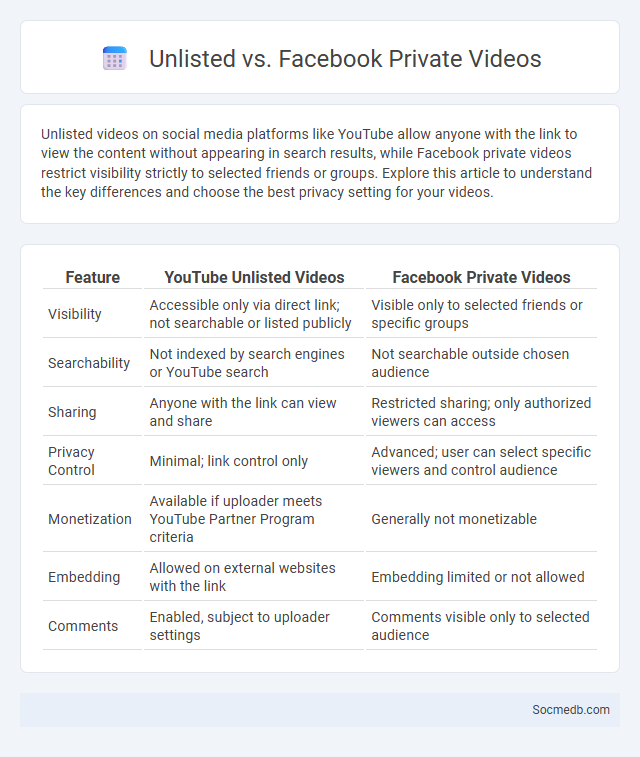
Photo illustration: Unlisted vs Facebook Private Videos
Unlisted videos on social media platforms like YouTube allow anyone with the link to view the content without appearing in search results, while Facebook private videos restrict visibility strictly to selected friends or groups. Explore this article to understand the key differences and choose the best privacy setting for your videos.
Table of Comparison
| Feature | YouTube Unlisted Videos | Facebook Private Videos |
|---|---|---|
| Visibility | Accessible only via direct link; not searchable or listed publicly | Visible only to selected friends or specific groups |
| Searchability | Not indexed by search engines or YouTube search | Not searchable outside chosen audience |
| Sharing | Anyone with the link can view and share | Restricted sharing; only authorized viewers can access |
| Privacy Control | Minimal; link control only | Advanced; user can select specific viewers and control audience |
| Monetization | Available if uploader meets YouTube Partner Program criteria | Generally not monetizable |
| Embedding | Allowed on external websites with the link | Embedding limited or not allowed |
| Comments | Enabled, subject to uploader settings | Comments visible only to selected audience |
Understanding Unlisted Videos: Definition and Features
Unlisted videos are a unique social media feature that allows content to be shared without appearing in public search results or on your channel. Only users with the direct link can view these videos, offering a controlled way to share content with specific audiences. Understanding how unlisted videos work helps you maintain privacy while leveraging social media for targeted communication.
Overview of Facebook Private Videos
Facebook private videos offer enhanced privacy settings, allowing users to restrict access to their video content to a select audience, such as friends or specific groups. These videos are not searchable through Facebook's public search, ensuring greater control over who views the content. Privacy settings can be customized through the video's audience selector, enabling users to manage visibility effectively and protect personal or sensitive information.
Unlisted Videos vs Facebook Private Videos: Key Differences
Unlisted videos on social media platforms allow content to be viewed only by those with a direct link, ensuring your videos remain hidden from public search but accessible without requiring permission. Facebook private videos restrict access further by limiting viewers to specific friends or groups you select, offering a more controlled sharing environment. Understanding these differences helps you tailor your video privacy settings to match the desired audience reach and confidentiality.
Privacy and Accessibility: Who Can Watch?
Social media platforms implement various privacy settings allowing users to control who can watch their content, ranging from public access to restricted groups such as friends or custom lists. Accessibility features like closed captions and screen reader compatibility ensure that diverse audiences, including those with disabilities, can engage with content securely and comfortably. Enhanced privacy controls combined with inclusive design promote a safer, more accessible social media environment for all users.
Sharing Options: Links, Embeds, and Permissions
Social media platforms offer versatile sharing options including direct links, embedded posts, and customizable permissions to control content visibility and interaction. Links provide a quick way to distribute content, while embeds allow seamless integration into websites or blogs, enhancing user engagement and reach. Your choice of permissions ensures that your shared content aligns with your desired level of privacy and audience access, optimizing social media presence.
Use Cases: When to Choose Unlisted vs Private
Use unlisted settings on social media to share content discreetly with specific users via direct links while keeping it hidden from public searches and profiles. Choose private settings when content requires strict access control, allowing only approved followers or connections to view posts, enhancing security and exclusivity. Unlisted options suit casual sharing and broader limited distribution, whereas private settings are optimal for sensitive or personal information.
Platform Limitations and Compatibility
Social media platforms often impose limitations on file types, sizes, and aspect ratios for uploads, affecting user content compatibility and visibility. Certain features or integrations may only be available on specific devices or operating systems, restricting seamless cross-platform user experience. Understanding these constraints is essential for optimizing content performance and maximizing engagement on networks like Instagram, Facebook, Twitter, and TikTok.
Video Security and Potential Risks
Video security on social media platforms is crucial to protect your personal content from unauthorized access, misuse, or hacking. Potential risks include data breaches, phishing attacks targeting video uploads, and identity theft through deepfake videos. Ensuring strong privacy settings and using trusted security tools can help you safeguard your digital video assets effectively.
Analytics and Viewer Insights Comparison
Social media analytics tools provide in-depth viewer insights by tracking engagement metrics, audience demographics, and content performance across platforms such as Facebook, Instagram, and Twitter. Comparing these insights enables marketers to identify trends, optimize content strategies, and increase ROI by understanding which posts generate the highest interactions and retain viewer attention. Advanced analytics also offer sentiment analysis and real-time data, allowing businesses to adjust campaigns promptly and target specific audience segments effectively.
Best Practices for Sharing Sensitive Video Content
Sharing sensitive video content on social media requires strict adherence to privacy guidelines and platform policies to protect individuals' rights and prevent misuse. Utilize secure permissions settings, avoid sharing identifiable information without consent, and apply content warnings to inform viewers about the nature of the material. Employ encryption tools and restrict the audience to trusted groups to minimize exposure and maintain ethical standards.
 socmedb.com
socmedb.com